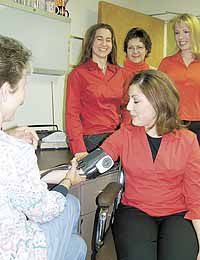| For your heart, your health, your life. Go Red for Women is the American Heart Association’s national call for women to take charge of their heart health, and live stronger, longer lives. Talia Valdez-Martinez is taking charge of her heart health by getting her cholesterol checked. Also supporting healthy lifestyle choices are Danielle Pendergrass, Viki Bowman and Rebecca Mason. Dottie Flemett is a nurse with the health department. |
Why would a group of young women show up at their work places Friday all wearing red? Because of ignorance around the risk of heart disease, Friday was set aside for a national campaign drawing attention to the risks of heart disease among women. The local chamber kicked off the campaign while each getting checked at the local health department.
`Cardiovascular disease, including stroke,�claims more women’s lives than the next seven causes of death combined, nearly 500,000 a year, nearly twice as many as all forms of cancer. One in�two and a half women will die of heart disease�or stroke, compared with one in�30 from breast cancer. “But you can substantially reduce many of your risk factors for heart disease and stroke with a few�simple lifestyle changes,” says Rebecca Mason, spokesperson for the group.
“You can do a lot to prevent cardiovascular disease and stroke,” she explained. “It begins by learning all you can about the serious health threats and working to reduce your risks. More research needs to be done on heart disease and stroke in women, but we already can share a lot of life-enhancing information. Educate yourself and your family. Then do something about it.”
Why are women more at risk for heart disease? In the past, many of the major cardiovascular research studies were conducted on men.�Results of clinical studies under way may help clarify the gender differences that affect diagnosis and treatment of women with heart disease.
Clinicians and patients often attribute chest pains in women to noncardiac causes, leading to misinterpretation of their condition.
Both women and men may present “classic” chest pain that grips the chest and spreads to the shoulders, neck or arms. Women may have a greater tendency to have atypical chest pain or to complain of abdominal pain, toothache, difficulty breathing (dyspnea), nausea and unexplained fatigue.
Women may avoid or delay seeking medical care, perhaps out of�denial or not being aware of both typical and atypical heart attack symptoms.
Since women tend to have heart attacks later in life than men do, they often have other diseases (such as arthritis or osteoporosis) that can mask heart attack symptoms. Increased age and the more advanced stage of coronary heart disease in women can affect treatment options available to physicians. Increased age can also help explain women’s greater mortality after heart attacks.
Some diagnostic tests and procedures may not be as accurate in women, so physicians may avoid using them. That means the disease process resulting in a heart attack or stroke may not be detected in women until later, with more serious consequences.
The exercise stress test, or stress ECG, may be less accurate in women. For example, in young women with a low likelihood of coronary heart disease, an exercise stress test may give a false positive result.� In contrast, single-vessel heart disease, which is more common in women than in men, may not be picked up on a routine�exercise stress�test.
More precise noninvasive and less invasive diagnostic tests tend to cost more. These include thallium, sestamibi or echocardiographic stress tests.
Know blood pressure and cholesterol and treat any underlying diseases such as diabetes. Talk with health care providers and discuss what tests are needed to assess heart health. Free blood pressure screenings are done every Friday at the Southeastern Utah Health Department from 3:30 p.m. to 4:30 p.m. A self-referred, 12 hour fasting, cholesterol test can be done at Castleview Hospital for $21. Call for an appointment and be sure to discuss the results with a health care provider.
Diet and exercise are the cornerstones of preventing and managing heart disease. Don’t have time to exercise? That’s okay. Don’t think exercise, think action. Standing is better than sitting, walking is better than standing. Increase physical activity to at least 30 minutes a day on most days of the week, even if only for 10 minutes at a time. Healthy food habits can help reduce three risk factors for heart attack and stroke�� high blood cholesterol, high blood pressure and excess body weight.
Here are some other tips that can help out. Use the stairs, up and down, instead of the elevator. Start with one flight of stairs and gradually build up to more.
Sweep the floor, wash windows or vacuum the carpet briskly. Take children to the park and play with them. Don’t sit on the bench and watch.
Write physical activity “appointments” into a daily planner or computer schedule.�
Take a walk after dinner instead of watching television.
Park a few blocks from the office or store and walk the rest of the way. Take an activity break. Get up, stretch and walk around. Hide the remote control and get up to change channels on the TV. Eat a balanced diet�emphasizing fruits, vegetables, cereal and grain products, fat-free and low-fat dairy products, legumes, nuts, fish, poultry and lean meats. Mix one-half regular soda with one-half diet soda until the taste of diet soda becomes tolerable.
Eat foods low in saturated fat and cholesterol. Enjoy a large glass of ice water, hot tea or another calorie-free beverage. Garnish with a twist of lemon or lime and sip slowly.
When using recipes that serve a large number of people, divide the extra portions into containers to eat throughout the rest of the week. Eat with other people. Most people will eat less with others than they will eat when alone.
For more information on heart disease, contact Jessie Huff, RN at the Southeastern Utah Health Department at 435-637-3671. They are a resource for heart disease and stroke prevention.

